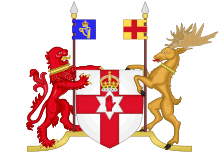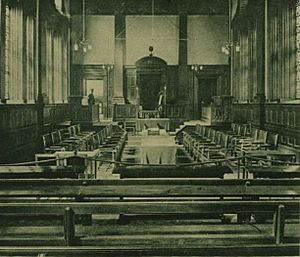Senate of Northern Ireland facts for kids
Quick facts for kids Senate of Northern Ireland |
|
|---|---|
| Devolved Parliament | |

Arms of Northern Ireland, 1924–1972
|
|
| Type | |
| Type | |
| History | |
| Established | 7 June 1921 |
| Disbanded | 30 March 1972 |
| Leadership | |
|
Speaker
|
Lord Glentoran (last)
|
|
Leader
|
Sir Jack Andrews (last)
|
| Elections | |
| Elected by the Commons via STV | |
| Meeting place | |
| Senate Chamber Parliament Buildings, Stormont, Belfast |
|
The Senate of Northern Ireland was like an important part of the government in Northern Ireland. It was the "upper house" of the Parliament of Northern Ireland. Think of it as a second group of lawmakers, similar to how some countries have two parts to their parliament. The Senate was created in 1920 and stopped existing in 1973.
Contents
What Did the Senate Do?
The Senate of Northern Ireland didn't have much real power. Its main job was supposed to be checking and improving laws that came from the other part of the parliament, called the House of Commons. However, in reality, the Senate usually just voted the same way as the House of Commons.
Where the Senate Met
From 1932 until 1972, the Senate of Northern Ireland met in a special room called the Senate Chamber. This room was inside the Parliament Buildings in Stormont, just outside Belfast. To be similar to the British House of Lords in the UK, the members of the Senate sat on red benches.
Who Were the Senators?
The Senate had 26 members.
- 24 members were chosen by the House of Commons of Northern Ireland. They used a special voting system called the Single Transferable Vote (STV). These senators served for two terms of the House of Commons.
- Two members were automatically part of the Senate because of their other jobs: the Lord Mayor of Belfast and the Mayor of Londonderry.
When a senator needed to be replaced, only members of the Commons from the same area would vote for their replacement.
Important Roles in the Senate
The main leaders and officials in the Senate were:
- The Speaker, who led the meetings.
- Two Deputy Speakers.
- The Leader of the House.
- The Deputy Leader of the House (this role ended in 1961).
Political Groups in the Senate
Over its history, 142 different people served in the Senate. The Senate was mostly made up of members from the Unionist party. This was even more true than in the House of Commons. This happened because the Lord Mayor of Belfast and Mayor of Londonderry were usually Unionists. Also, some other political groups were too small to get their own senator elected.
However, one member from the Nationalist party, Thomas Stanislaus McAllister, served as a Deputy Speaker for two periods.
The table below shows how many elected members from different political groups were in the Senate after each election. It doesn't show changes that happened between elections.
| Election | Unionist | Labour | Nationalist | Ind. Unionist | Independent |
|---|---|---|---|---|---|
| 1921 | 24 | 0 | 0 | 0 | 0 |
| 1925 | 23 | 1 | 0 | 0 | 0 |
| 1929 | 20 | 1 | 3 | 0 | 0 |
| 1933 | 18 | 0 | 5 | 1 | 0 |
| 1937 | 20 | 0 | 4 | 0 | 0 |
| 1945 | 18 | 1 | 2 | 1 | 0 |
| 1949 | 17 | 1 | 5 | 1 | 0 |
| 1953 | 18 | 0 | 5 | 0 | 1 |
| 1957 | 19 | 0 | 4 | 0 | 1 |
| 1962 | 18 | 1 | 4 | 0 | 1 |
| 1965 | 18 | 2 | 4 | 0 | 0 |
| 1969 | 16 | 2 | 5 | 0 | 0 |
Senators with Special Titles
Many senators also held special titles, like "Lord" or "Duke." Nine senators were or became peers (people with noble titles) while they were in the Senate. These included the third and fourth Dukes of Abercorn, Viscount Bangor, Viscount Charlemont, the Marquess of Dufferin and Ava, Lord Glentoran, the Marquess of Londonderry, Lord Massereene and Ferrard, and Lord Pirrie.
At least three other senators later received peerage titles. For example, Lord Robert Grosvenor became the Duke of Westminster, and Sir Basil Brooke became Viscount Brookeborough.
End of the Senate
The Senate, along with the House of Commons, was temporarily stopped in 1972. It was then completely ended by a law called the Northern Ireland Constitution Act 1973. Today, the old Senate Chamber is used as a meeting room for committees of the Northern Ireland Assembly.
See also


